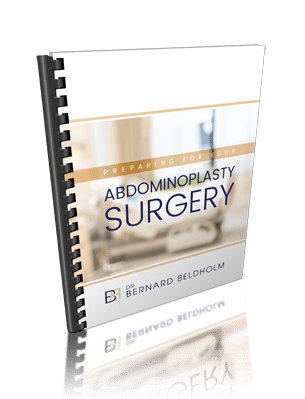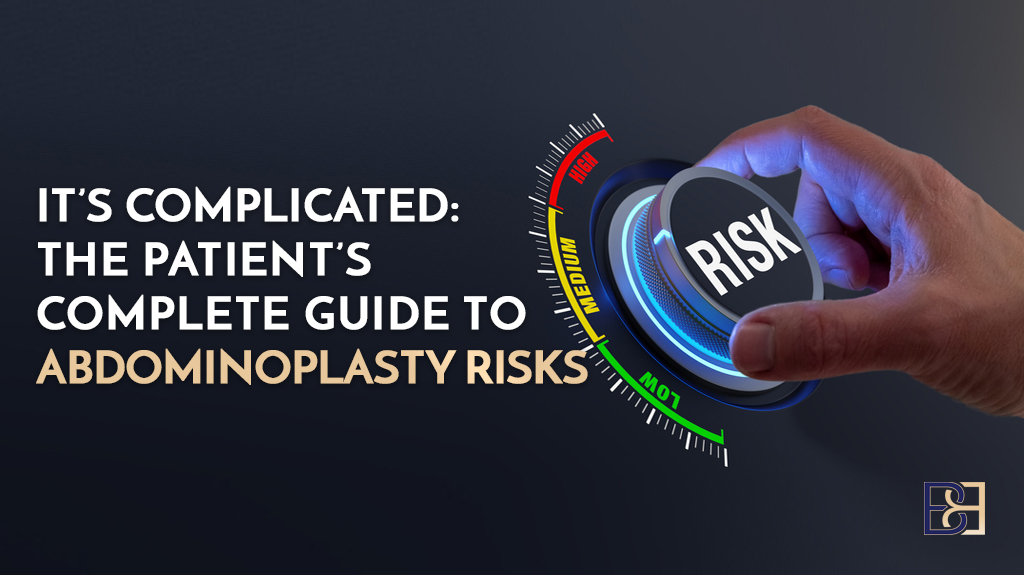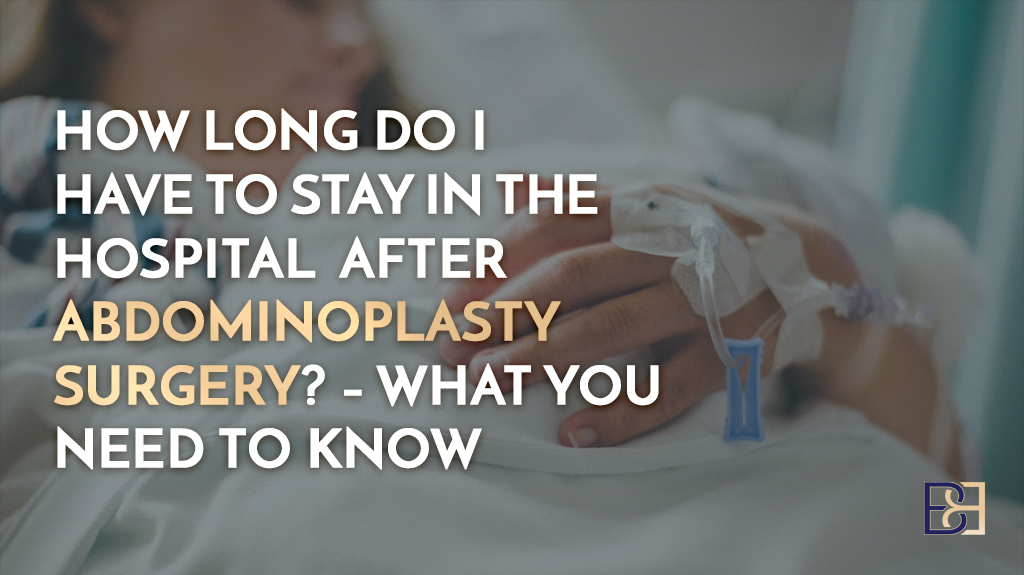A Mini VASER Lipo-Abdominoplasty (Mini Abdominoplasty with VASER suction assisted lipectomy) procedure targets redundant skin tissue on the lower abdominal region that may result from pregnancy.
Many women experience post-pregnancy side effects, including redundant loose skin in the abdominal region and separated abdominal muscles (diastasis recti), which can be the result of significant weight changes during pregnancy and childbirth. Redundant abdominal skin not only affects the abdominal contour but can also interfere with normal bodily functions.

Disclaimer: Operation performed by Dr Bernard Beldholm. Adult content, surgery has risks; individual results vary, seek 2nd opinion. Please see the full disclaimer.
Book your appointment online now
As a post-pregnancy patient, you may find it challenging to remove the excess abdominal skin tissue through diet, exercise, or other non-surgical procedures alone, requiring a more effective surgical procedure. I recommend a mini abdominoplasty procedure to women who visit my clinic to treat minimal amounts of redundant skin on the lower abdominal area after pregnancy.
Allow me to take you deeper into the effectiveness of a mini abdominoplasty in treating post-pregnancy redundant and loose abdominal skin.

Disclaimer: Operation performed by Dr Bernard Beldholm. Adult content, surgery has risks; individual results vary, seek 2nd opinion. Please see the full disclaimer.
Are You Suitable for a Mini VASER Lipo-Abdominoplasty?
A Mini VASER Lipo-Abdominoplasty (Mini Abdominoplasty with VASER suction-assisted lipectomy) is a procedure that removes redundant skin and fat tissue and muscle separation (Diastasis recti) in the lower abdominal region. Separated abdominal muscles and loose skin on the lower abdomen are common side effects during and after pregnancy. It also targets adipose tissue (Fat) in the abdominal area.
A study on diastasis recti during pregnancy notes that “[t]he prevalence of mild DRA (diastasis recti abdominis) was high both during pregnancy and after childbirth. Prevalence of DRA was 33.1%, 60.0%, 45.4%, and 32.6% at gestation week 21, 6 weeks, 6 months and 12 months postpartum, respectively.”
It’s important to note that mini abdominoplasty only treats minimal skin and diastasis recti on the lower abdomen. Therefore, I recommend traditional mini Abdominoplasty to only post-pregnancy women with minimal redundant skin on the lower abdomen and minimal or no muscle separation (Diastasis recti). Post-pregnancy women with significant, redundant skin and muscle separation (Diastasis recti) in the entire region will require a different abdominoplasty procedure for muscle tightening.
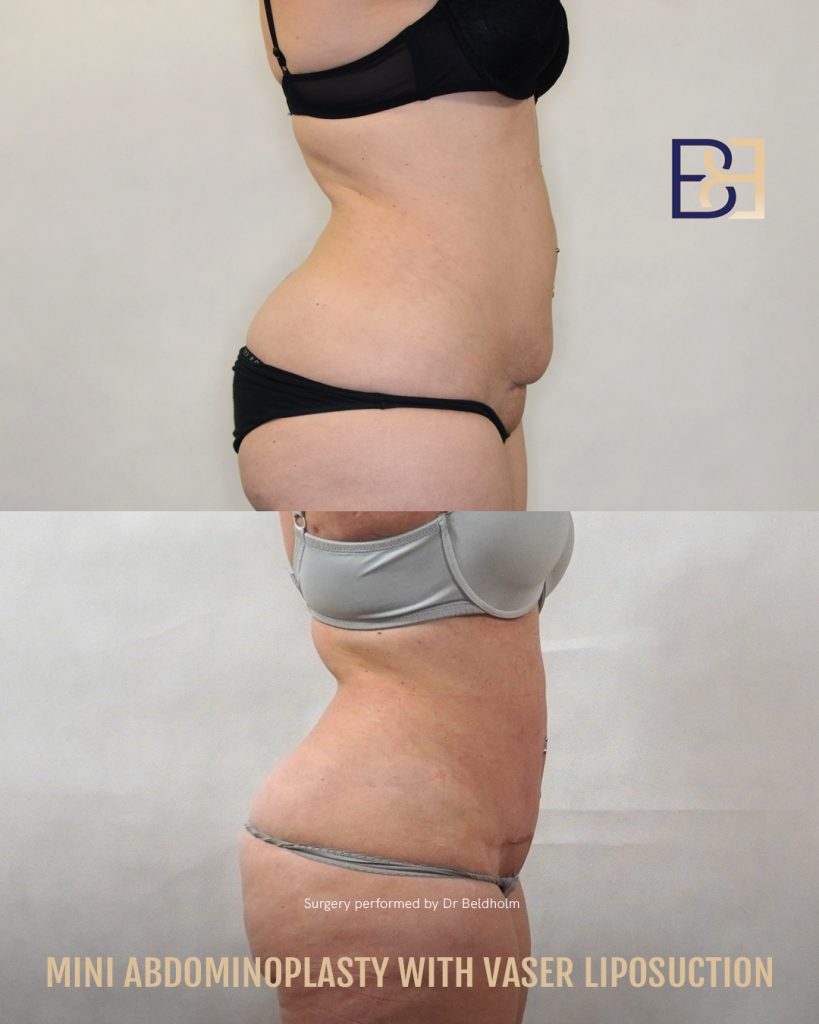
Tattoo blurred for privacy
Disclaimer: Operation performed by Dr Bernard Beldholm. Adult content, surgery has risks; individual results vary, seek 2nd opinion. Please see the full disclaimer.
Mini VASER Lipo-Abdominoplasty Candidate Checklist
Candidates for a mini Abdominoplasty should meet the following requirements.
- Minimal redundant skin on the lower abdominal region after pregnancy
- Minimal or no muscle separation (Diastasis recti) on the lower abdominal region after pregnancy
- No redundant skin and muscle separation (Diastasis recti) on the upper abdominal wall after pregnancy
- Reached stable weight after significant weight loss and maintained it steadily for a minimum of 6 months
- Good general health
- Non-surgical treatments like eating a healthy diet and exercising regularly have failed.
- Have an understanding of the potential risks and have realistic expectations.
- Are a non-smoker or agree to refrain from smoking for 6 weeks before and after the procedure
You should note that these are general qualifications for a post-pregnancy patient and don’t guarantee suitability for your surgical journey. I invite you to schedule a consultation with me to confirm suitability.
Comparison Between Mini and Standard or Full Abdominoplasty
Both mini and full abdominoplasty target abdominal skin. However, the two vary, depending majorly on the amount of skin tissue being removed and the location of the skin.
A full abdominoplasty is extensive and targets excess skin tissue in the entire abdominal region (upper and lower), while a mini abdominoplasty surgery targets only the lower abdomen. Also, a full abdominoplasty suits patients with significant, redundant skin and muscle separation (Diastasis recti), while a mini abdominoplasty is ideal for patients with minimal redundant skin and separation of the underlying muscles. In addition, a full abdominoplasty involves belly button repositioning, which isn’t part of a mini tummy tuck (Abdominoplasty) procedure.
Additionally, full abdominoplasty is more invasive than a mini abdominoplasty, increasing the surgical time and recovery period.
Mini VASER Lipo-Abdominoplasty Surgery Process
As noted earlier, I almost always incorporate VASER Liposuction (Suction-Assisted Lipectomy) into a mini abdominoplasty. I refer to the procedure as mini VASER lipo-abdominoplasty, which takes 2-3 hours. Let’s look at what happens during this procedure.
Initial Consultation
During the initial consultation, I will assess your health, the amount of excess skin to be removed, and your suitability for a mini abdominoplasty. I will then discuss the possible risks, and how to prepare for the surgery and help you set a date for the surgery.
Anaesthesia
On the day of surgery, I will meet you at the anaesthetic bay where I’ll clarify all your last-minute questions and walk you through the expected surgery process, risks, and recovery. I’ll then make marks on your abdomen to show the excision area and the incision site. The anaesthetist will administer the anaesthesia while you’re lying on the operating table. I prefer general anaesthesia; therefore, the patient will be fully asleep for the surgery.
VASER Liposuction (Suction-Assisted Lipectomy)
The next step involves VASER Liposuction (Suction-Assisted Lipectomy), a specialised liposuction procedure that uses ultrasonic waves and high-frequency vibration to break down and liquefy the fatty tissue to remove the excess fatty tissue. During the procedure, I’ll first inject a wetting solution (tumescent solution) into the abdominal skin through small incisions. The wetting solution consists of sterile saline, local anaesthesia, and medication that constricts blood flow, reducing bleeding, bruising, and swelling.
I’ll then insert a VASER probe through the incisions. The probe produces ultrasonic waves that break down and liquefy the excess fat, separating it from the skin. The next step involves using a cannula to suck the liquified fat and the wetting solution.

Diastasis recti Repair
After liposuction (suction-assisted lipectomy), I’ll make a horizontal incision a few inches longer than a C-section incision and just above the pubic region. The incision’s length depends on how much redundant skin you have, and underwear easily covers it. After dissecting the skin flap, I’ll repair any separated tummy muscles.
Removing Excess Skin
The last step involves removing the excess skin and tissue from the lower abdomen, typically below the belly button. This helps create a smoother and more toned appearance.
Closing the Wound
At this point, I will strategically close the wound using absorbable sutures and adhesive surgical glue to minimise scarring.
PICO Dressing
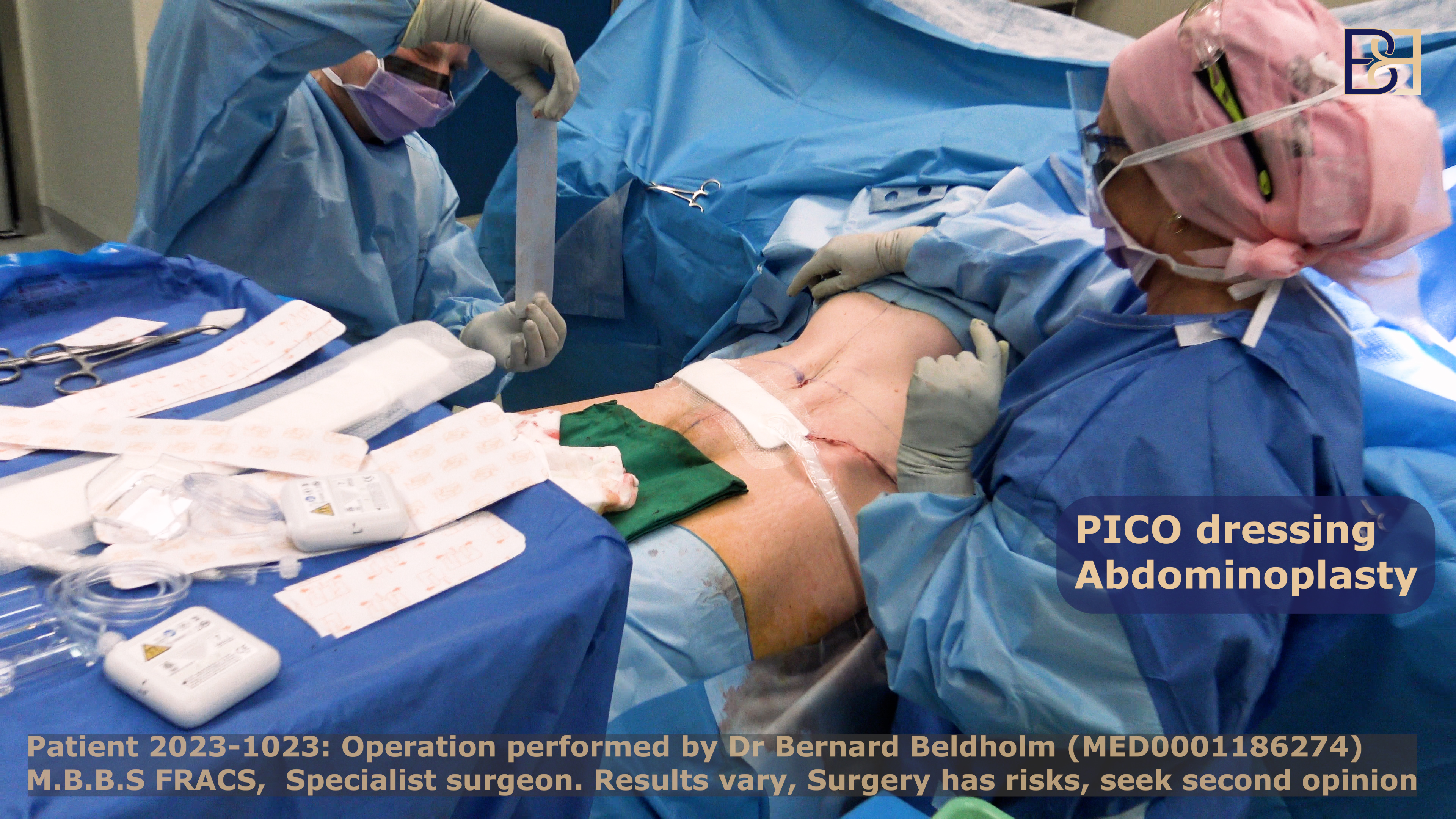
Next, I’ll dress the wound using PICO dressing, a type of negative pressure wound therapy that helps promote healing and reduce the risk of complications such as infection. I will apply it to the incision site after surgery and require you to use it for about 7 days to promote healing.
Compression Garment
Finally, I will place a support garment on the excision area to reduce swelling and support the healing tissue. I expect you to wear the compression garment for at least 4 weeks.
Recovering from Mini VASER Lipo-Abdominoplasty Surgery
Mini abdominoplasty is an inpatient day procedure. The hospital stay after the procedure is a few hours. Therefore, it’s important that someone drives you home to begin your aftercare. Also, ensure you take some time off work, about 1 to 2 weeks, to concentrate on recovery.
I will provide you with a list of post-operative care instructions after surgery. Following these instructions and attending follow-up sessions. Below is a common recovery timeline.
During the first 1-2 days after surgery, you will experience intense pain, swelling, bruising, and soreness around the incision. I prescribe painkillers for my patients to ease the pain. During this period, ensure enough sleep and rest while staying hydrated. After around 3 days, I encourage my patients to take light walks around the house to increase blood flow.
Post-surgical side effects will subside gradually, and most patients can resume light activities by the first to second week. However, I advise patients to avoid strenuous activities and continue to wear the compression garment for at least 4 weeks.
By week 6-8, most patients will begin to notice the procedure’s results. However, it will take longer before you enjoy the final results of a mini VASER lipo-abdominoplasty. Residual swelling takes between 3 and 6 months to subside, while scars take 12-18 months to fade.
How Long Should You Wait After Pregnancy Before Undergoing a Mini Abdominoplasty
My recommendation is that patients wait at least 12 months after childbirth before undergoing any abdominoplasty procedure, including mini Abdominoplasty surgery. This ensures that they recover from childbirth and attain their ideal weight. In addition, it offers them time to nurse and bond with their newborn.
What Are the Benefits of a Mini VASER Lipo-Abdominoplasty?
A mini abdominoplasty is less invasive compared to other abdominoplasty procedures. Below are the key benefits of a mini VASER lipo-abdominoplasty.
- Targets abdominal contour and muscle tone
- Reduced surgery time
- Reduced scarring
- Smaller incision
- Correction of diastasis recti (if in the lower abdomen)
- Smaller waist
- Reduced visibility of a C-section scar
- Reduced recovery time than other procedures
- Only removes excess skin below the belly button, making a belly button incision not necessary.
Mini VASER Lipo-Abdominoplasty Surgery Risks and Complications
Mini Abdominoplasty is a surgical procedure, hence posing several risks and complications, including:
- Swelling and bruising
- Hematoma
- Seroma
- Chronic pain
- Abnormal scarring
- Loss of skin sensation
- Skin necrosis
- Skin infections
- Prolonged wound healing
- Wound dehiscence (Incision wound reopening)
- Allergic reaction to the anaesthesia
- Unsatisfactory results
How Does the Cost of a Mini and Full Abdominoplasty Compare?
The cost of a mini abdominoplasty is lower than that of a full abdominoplasty because the procedure is less invasive, takes less time to perform, and does not require a hospital stay.
These include individual goals and the patient’s overall health.
Factors Affecting the Cost of a Mini Abdominoplasty Procedure.
The cost of abdominoplasty can vary depending on the following factors:
- Overall health
- Goals
- Liposuction (suction-assisted lipectomy)
- Diastasis recti
- Your specialist surgeon experience
- Location of Clinic/Hospital
- Medicare/MBS Number
- Private Insurance
- Hospital Fees
- Medication
- Compression Garment
- PICO Dressing
- Anaesthetist Fee
- Assistant Fees
FAQs
Does a Mini Abdominoplasty Include VASER liposuction (suction-assisted lipectomy)?
I almost always include VASER liposuction (suction-assisted lipectomy) in my mini abdominoplasty procedures. This reduces the risk of re-operation due to unsatisfactory results. The procedure is known as a mini VASER lipo-abdominoplasty.
How Long Will I Need to Take Off Work?
I advise my patients to take at least 2 weeks off work. This will allow you to focus fully on recovery. Many patients can resume their normal chores 2-3 weeks after surgery.

Dr. Bernard’s Final Word
Pregnancy has its share of side effects, including separated abdominal muscles (DIastasis recti) and redundant and excess skin tissue and fat in the abdominal region. These may affect how your body looks post-pregnancy. You may find it hard to return to your previous body profile through non-conventional practices like exercise and a healthy diet. If so, you might be the right patient for my mini VASER lipo-abdominoplasty.
Book a consultation at my clinic today.
References
- Nagy, M. W., & Vanek, P. F., Jr (2012). A multicenter, prospective, randomised, single-blind, controlled clinical trial comparing VASER-assisted Lipoplasty and suction-assisted Lipoplasty. Plastic and reconstructive surgery, 129(4), 681e–689e.
- Greminger R. F. (1987). The mini-abdominoplasty. Plastic and reconstructive surgery, 79(3), 356–365.
- Sperstad, J. B., Tennfjord, M. K., Hilde, G., Ellstrøm‐Engh, M., & Bø, K. (2016). Diastasis recti abdominis during pregnancy and 12 months after childbirth: prevalence, risk factors and report of lumbopelvic pain. British Journal of Sports Medicine, 50(17), 1092–1096.
- Hoyos, A. E., & Millard, J. A. (2007). VASER-Assisted High-Definition Liposculpture. Aesthetic Surgery Journal, 27(6), 594-604.
- Michalska, A., Rokita, W., Wolder, D., Pogorzelska, J., & Kaczmarczyk, K. (2018). Diastasis recti abdominis – a review of treatment methods. Ginekologia polska, 89(2), 97–101.
- Sperstad, J. B., Tennfjord, M. K., Hilde, G., Ellström-Engh, M., & Bø, K. (2016). Diastasis recti abdominis during pregnancy and 12 months after childbirth: prevalence, risk factors and report of lumbopelvic pain. British journal of sports medicine, 50(17), 1092–1096.
- Winocour, J., Gupta, V., Ramirez, J. R., Shack, R. B., Grotting, J. C., & Higdon, K. K. (2015). Abdominoplasty: Risk Factors, Complication Rates, and Safety of Combined Procedures. Plastic and reconstructive surgery, 136(5), 597e–606e.
- Mast B. A. (2005). Safety and efficacy of outpatient full abdominoplasty. Annals of plastic surgery, 54(3), 256–259.
- Hafezi F, Nouhi A. Safe abdominoplasty with extensive liposuctioning. Ann Plast Surg. 2006 Aug;57(2):149-53.
- Rubin P, Jewell ML, Richter D, Uebel CO. Body Contouring and Liposuction. 1st ed. In: Pitanguy I, editor. Introduction. United Kingdom: Elsevier Saunders; 2013. pp. 1-3


